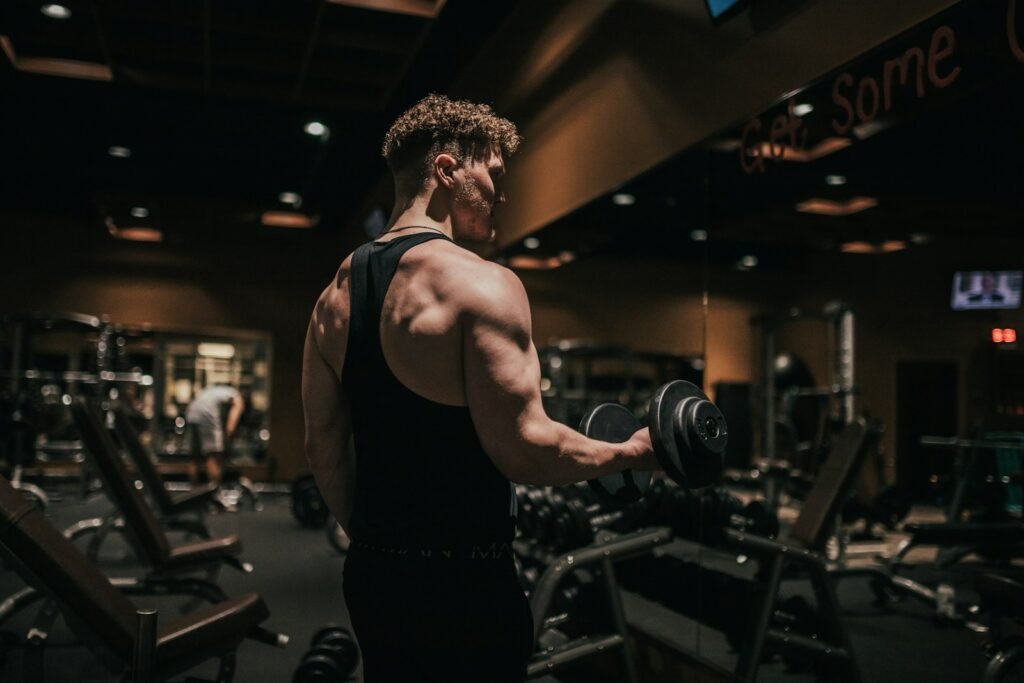I used to be skinny and didn’t know where to start at the gym. It felt overwhelming, and I was scared of hurting myself. But then I found full-body workouts, and everything changed. I started seeing results, felt more confident, and learned that changing your body is possible.
This beginner full-body workout is for men just starting out. It’s designed to help you get stronger, build muscle, and get in better shape. By working out your whole body at once, you’ll make the most of your time at the gym. You’ll see progress, even if you’re busy. Let’s look at the best exercises, tips, and FAQs to help you get the best results.
Key Takeaways
- Full-body workouts can lead to significant fitness improvements with fewer gym visits per week.
- Achieving the right balance between workout intensity and recovery is key for muscle growth.
- Proper nutrition, protein intake, hydration, and recovery are essential for muscle growth.
- Beginners should focus on compound exercises and proper form to build a solid foundation.
- Progressive overload and training advancement are vital for continued progress.
Understanding Full-Body Training Fundamentals
For men starting out, full-body workouts are a great choice. They work on many muscle groups at once. This offers benefits like better muscle coordination, more calorie burn, and saving time.
Benefits of Full-Body Workouts
- Enhances muscle coordination and balance
- Maximizes calorie expenditure during and after exercise
- Saves time by combining multiple muscle groups in a single session
- Stimulates overall strength and functional fitness development
Key Movement Patterns
Effective full-body workouts for beginners focus on key movements. These include hinging, squatting, pushing, pulling, and carrying. Exercises that cover these patterns help ensure balanced muscle growth.
Training Frequency and Recovery
Newbies to full-body workouts should aim for 2-3 sessions a week. This allows for enough rest and muscle growth. Remember, 48-72 hours of rest between sessions is key for the best results.
| Workout Frequency | Recovery Time |
|---|---|
| 2-3 full-body sessions per week | 48-72 hours between workouts |
“Incorporating a variety of movement patterns like squatting, pushing, pulling, hinging, and carrying helps to optimize training efficiency.”
Essential Equipment and Gym Setup for Beginners
Starting your beginner’s gym guide means getting the right gear. This is key for a good beginner men’s fitness routine. Whether at the gym or home, the right setup boosts your progress.
At the gym, you’ll need barbells, dumbbells, weight benches, and resistance bands for a full-body workout. For no-equipment workout options, bodyweight exercises are great. They help build strength and endurance without extra gear.
For your gym space, start with a squat rack, bench press station, and pull-up bar. These are essential for doing compound exercises. These exercises work on many muscles at once, which is vital for a good beginner men’s fitness routine.
Training at home? You can follow a beginner’s gym guide with just a few pieces. Adjustable dumbbells and a flat weight bench are enough. They let you do many exercises, building strength and muscle at home.
| Gym Equipment | At-Home Equipment |
|---|---|
|
|
No matter where you train, focus on the basics. The right equipment is key for your beginner men’s fitness routine goals. It helps you get the most out of your no-equipment workout or gym sessions.
Beginner full-body workout for men Full-body workout for beginners Men’s workout
Starting a strength training journey is exciting. Building a full-body workout routine is key for muscle growth and fitness. A mix of compound and isolation exercises helps you grow muscles, get stronger, and reach your fitness goals.
Compound Exercises
Compound exercises work many muscles at once. They should be the core of your workout. Key compound lifts include:
- Squats
- Deadlifts
- Bench Press
- Rows
- Overhead Press
Isolation Movements
Isolation exercises target specific muscles. They help balance muscle growth. Add these to your routine:
- Bicep Curls
- Tricep Extensions
- Calf Raises
- Lateral Raises
- Leg Extensions
Exercise Selection Guidelines
Focus on compound exercises for a strong base. They work many muscles at once. Then, add isolation exercises to target specific muscles for balance.
Start with lighter weights and focus on form. Gradually increase weight and volume as you get stronger. This way, you avoid injuries and make steady gains in muscle and strength.
“The key to a successful beginner full-body workout is to strike a balance between compound and isolation exercises, allowing you to build a strong, well-rounded physique.”
Proper Form and Technique Guidelines
Proper form and technique are key for effective exercises, even more so for beginners. They help prevent injuries and make your workouts more effective. This way, you’ll see better results.
When doing beginner workout tips for men, keep your spine straight. Use your core to keep your body stable. This ensures the right muscles are working, not just momentum.
- For full-body workout tips for beginners, like squats, keep your chest up and your knees in line with your toes. Make sure your weight is on your heels.
- In deadlifts, keep your back flat and push through your heels. Let the bar get close to your body.
- For bench presses, pull your shoulder blades back. Keep your feet on the ground and lower the bar to your chest.
Proper technique is vital for effective exercises and injury prevention. Spend time learning the basics. This will help you achieve a safe and successful full-body workout for men.
“The key to building a strong, balanced physique is not just about the exercises you do, but how you do them. Proper form is the foundation for all your training goals.”
Workout Structure and Programming
Creating a good men’s workout routine or full-body workout for beginners is key. The structure and programming of your workouts are very important. A well-planned beginner men’s fitness routine helps you get the best results and keep improving.
Sets and Repetitions
A good full-body workout for beginners should have 6-8 exercises. Do 2-4 sets of each exercise, with 8-12 reps in each set. This helps your muscles grow and get stronger without feeling too much as a beginner.
Rest Periods
Rest times vary with the exercise type. For exercises like bicep curls, rest for 60-90 seconds between sets. For big exercises like squats, rest for 2-3 minutes.
Exercise Order
Start with compound exercises in your full-body workout for beginners. Then do isolation exercises. This order helps you focus on the harder exercises first. A good order is: squats, bench press, rows, shoulder press, lunges, bicep curls, and tricep extensions.
| Exercise Type | Sets | Reps | Rest Period |
|---|---|---|---|
| Compound Exercises | 2-4 | 8-12 | 2-3 minutes |
| Isolation Exercises | 2-4 | 8-12 | 60-90 seconds |
For a successful full-body workout for beginners, focus on form, increase intensity slowly, and rest well. With hard work and a good men’s workout routine, you’ll reach your fitness goals.
At-Home Full-Body Training Options
You don’t need fancy gym equipment for a full-body workout at home. You can do a great at-home workout for men with just your body and a few simple tools. The trick is to use no-equipment workout options that work all the major muscles.
Push-ups are a key bodyweight workout for men. Changing hand positions targets your chest, shoulders, and triceps. Squats and lunges work your lower body. Planks and mountain climbers strengthen your core. Resistance bands add intensity to exercises like rows, bicep curls, and overhead presses.
A sample at-home full-body circuit could include:
- 3 sets of 10-15 reps of bodyweight squats
- 3 sets of 10-15 reps of push-ups
- 3 sets of 10-15 reps of walking lunges
- 3 sets of 10-15 reps of dumbbell rows (if you have weights)
- 3 sets of 15-second plank holds
- 3 sets of 30 jumping jacks
If you have dumbbells, you can add more to your at-home workout for men. Try overhead presses, bicep curls, and shoulder raises. Focus on exercises that work many muscles at once.
Consistency is important. Do this bodyweight workouts for men routine 2-4 times a week. Make sure to rest well between workouts. Add a balanced diet, and you’ll build strength and muscle at home.

Progressive Overload and Training Advancement
To keep improving in muscle building and strength training, use progressive overload. This means slowly increasing the workout’s demands. Your muscles will get stronger as they adapt to these changes.
Weight Progression
When you can do all sets and reps easily, add 5-10% more weight. This keeps your muscles challenged and helps them grow. The goal is to lift heavier weights as you train.
Volume Manipulation
You can also progress by adding more sets or reps. This higher volume helps your muscles grow more. Try to increase your volume by 5-10% every 2-4 weeks. This keeps your body challenged and helps you grow muscle.
Exercise Variations
Trying different exercises is another way to progress. Changing how you do an exercise can challenge your muscles in new ways. As you get better, try more complex exercises like barbell back squats and pull-ups.
Remember, progressive overload is key for getting better. Try to make your workouts harder every 2-4 weeks. With patience and regular effort, you’ll see your muscles and strength grow.
“Progressive overload is the key to building muscle and getting stronger over time. Without it, your results will stall after a few weeks.”
Nutrition and Recovery Strategies
Proper nutrition is key for muscle growth and recovery in your men’s fitness routine. Aim for a balanced diet with enough protein, complex carbs, and healthy fats. This supports your fat-burning workout and muscle building.
The American College of Sports Medicine (ACSM) suggests 1.2-1.7 grams of protein per kilogram of body weight daily. Carbs should be 1.2 – 1.5 grams per 2.2 pounds of body weight daily. Fats should be 20-35% of your daily calories.
Hydration is also vital. Drink at least half an ounce of water for every pound of body weight daily. This supports your men’s fitness routine and overall health.
Recovery strategies are just as important. Aim for 7-9 hours of quality sleep nightly. Rest days between fat-burning workouts for men are also key. Foam rolling and stretching can help with muscle soreness and recovery.
Supplements can also help with muscle building for beginners. Consider adding protein powder, creatine, and BCAAs to your routine. They can help maximize muscle growth and performance.
| Nutrient | Recommended Daily Intake | Benefits |
|---|---|---|
| Protein | 1.2-1.7 g/kg of body weight | Supports muscle growth and repair |
| Carbohydrates | 1.2-1.5 g/2.2 lbs of body weight | Provides energy for workouts and daily activities |
| Fats | 20-35% of daily calorie intake | Promotes hormone production and overall health |
| Vitamin D | Varies based on individual needs | Supports muscle function and growth |
| Calcium | Varies based on individual needs | Promotes muscle growth and strength |
| Magnesium | Varies based on individual needs | Aids in energy production and muscle function |
| Zinc | Varies based on individual needs | Essential for cellular metabolism and muscle repair |

“Proper nutrition is the foundation for your muscle building success. By fueling your body with the right nutrients, you’ll be able to maximize the benefits of your men’s fitness routine and see greater results.”
Conclusion
Full-body workouts are great for beginners to build strength and muscle. They focus on compound exercises and proper form. This helps you see big results.
Being consistent in your workouts is key. You also need good nutrition and rest. This combo leads to lasting success.
As you get stronger, you can make your workouts harder. This keeps you improving. Science backs up full-body training for muscle growth and better metabolism.
Try exercises like deadlifts, kettlebell swings, and burpees. They work many muscles at once. This makes your workouts more effective.
For a strong and healthy body, stick to a full-body workout routine. Stay dedicated and listen to your body. Enjoy reaching your fitness goals.




